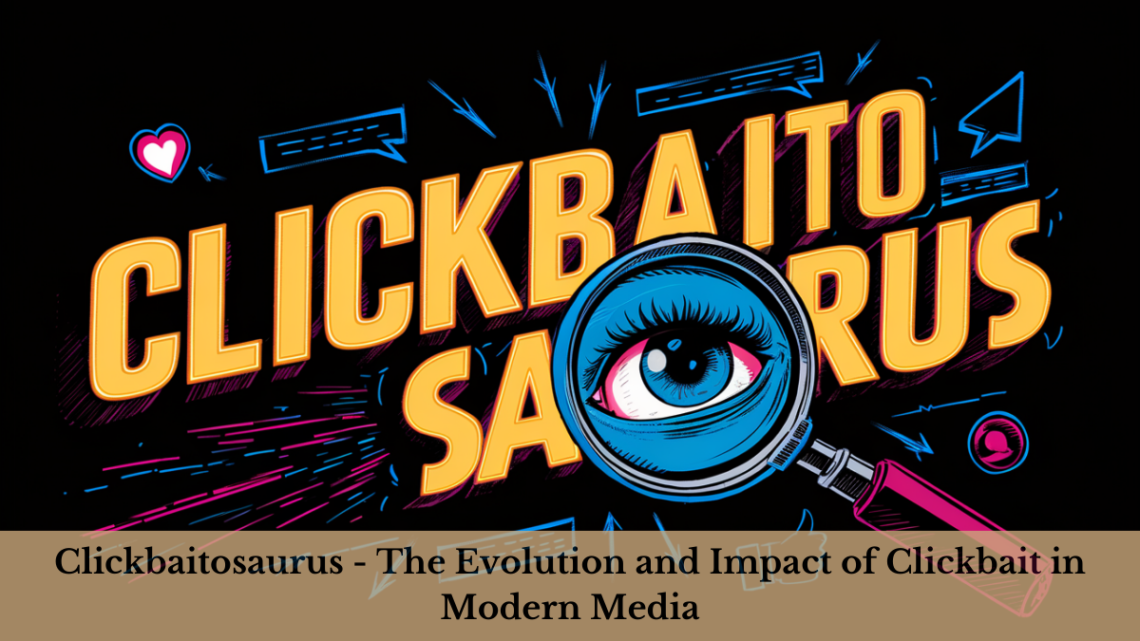
Clickbaitosaurus – The Evolution and Impact of Clickbait in Modern Media
Clickbait headlines have become an unavoidable part of the digital landscape. As users scroll through social media feeds or browse news sites, they are constantly bombarded with sensationalized headlines that promise more than they deliver. This phenomenon, often referred to as “clickbaitosaurus,” represents the persistent and evolving nature of clickbait tactics that have become deeply embedded in online content strategies.
Clickbaitosaurus represents exaggerated headlines that grab attention by misleading or sensationalizing content. It leverages curiosity and emotion but can undermine content quality and user trust.
In this comprehensive article, we will explore the origins, evolution, and impact of clickbaitosaurus on modern media. We will delve into the psychological triggers that make clickbait so effective, examine the ethical implications of using such tactics, and provide insights into how both consumers and content creators can navigate this challenging landscape. By the end, you will have a thorough understanding of the concept of clickbaitosaurus and how it shapes the way we consume information online.
What Is Clickbaitosaurus?
Clickbaitosaurus is a term that combines “clickbait” and “saurus,” implying the monstrous and enduring nature of clickbait in the digital era. Clickbait refers to headlines or content designed to attract attention and entice users to click on links, often by exaggerating or misleading the reader about the actual content. The “saurus” suffix suggests that these tactics have become a dominant force in the digital ecosystem, much like dinosaurs once ruled the Earth.
The Origins of Clickbait
The roots of clickbait can be traced back to the early days of journalism when sensational headlines were used to sell newspapers. Known as “yellow journalism,” these tactics focused on eye-catching headlines and scandalous stories to attract readers. However, with the rise of the internet, clickbait has taken on new forms and has become more sophisticated, driven by the need for online publishers to generate traffic and ad revenue.
Evolution into Clickbaitosaurus
As digital media evolved, so did clickbait tactics. What started as simple exaggerations in headlines has transformed into a more complex and pervasive strategy known as clickbaitosaurus. This evolution is marked by the use of advanced algorithms, data analytics, and psychological triggers to create headlines and content that are almost irresistible to users. Clickbaitosaurus represents the culmination of years of experimentation and refinement in the art of headline crafting.
The Anatomy of a Clickbaitosaurus Headline
To understand clickbaitosaurus, it’s essential to dissect the anatomy of a typical clickbait headline. These headlines often share common characteristics designed to exploit human curiosity, emotions, and biases. Here are some of the most common elements:
1. Exaggeration and Hyperbole
Clickbaitosaurus headlines often use exaggerated language to make ordinary content seem extraordinary. Phrases like “You Won’t Believe,” “Shocking,” or “Unbelievable” are commonly employed to create a sense of urgency and intrigue.
2. Curiosity Gap
The curiosity gap is a psychological trigger that clickbaitosaurus headlines exploit by withholding just enough information to make the reader feel compelled to click. For example, a headline like “This Simple Trick Will Change Your Life” leaves out the crucial details, forcing the reader to click to satisfy their curiosity.
3. Emotional Manipulation
Many clickbaitosaurus headlines aim to evoke strong emotions, such as anger, fear, or joy. Emotional content is more likely to be shared, and this virality is a key driver of clickbait success. Headlines that provoke a strong emotional response are often more effective at generating clicks.
4. Listicles and Numbered Titles
Listicles, or articles presented as lists, are a staple of clickbaitosaurus content. Titles like “10 Reasons Why…” or “7 Things You Need to Know…” are popular because they promise a concise and easily digestible format, appealing to readers’ desire for quick information.
5. Ambiguity and Mystery
Clickbaitosaurus headlines often employ vague or ambiguous language to create a sense of mystery. This tactic plays on the reader’s fear of missing out on something important or interesting. For example, a headline like “This Celebrity’s Secret Will Shock You” offers little information, compelling the reader to click for more details.
The Psychology Behind Clickbaitosaurus
Clickbaitosaurus is not just about clever headlines; it’s about understanding the psychological factors that drive human behavior. Content creators use these insights to craft headlines that tap into the subconscious mind, making it difficult for users to resist clicking.
1. The Curiosity Instinct
Humans are naturally curious creatures, and clickbaitosaurus takes full advantage of this trait. The curiosity gap, as mentioned earlier, is a powerful motivator. When presented with incomplete information, our brains are wired to seek closure, which often leads to a click.
2. Cognitive Ease
Clickbaitosaurus content is designed to be cognitively easy to process. Simple language, familiar patterns, and easily digestible formats like lists and short paragraphs make the content more appealing. The easier it is to consume, the more likely readers are to engage with it.
3. Emotional Triggers
Emotions are a significant driver of human behavior. Clickbaitosaurus headlines often target emotions like fear, anger, or happiness to increase engagement. Content that evokes strong emotions is more likely to be clicked on, shared, and discussed, further amplifying its reach.
4. Social Proof and FOMO
The fear of missing out (FOMO) is another psychological trigger that clickbaitosaurus headlines exploit. When a headline suggests that something is trending or widely discussed, readers are more likely to click to avoid being left out of the conversation. Social proof, such as the number of shares or comments, also plays a role in encouraging clicks.
The Impact of Clickbaitosaurus on Modern Media
Clickbaitosaurus has had a profound impact on modern media, influencing how content is created, distributed, and consumed. While clickbait tactics can drive significant traffic, they also come with drawbacks that affect both publishers and readers.
1. Degradation of Content Quality
One of the most significant impacts of clickbaitosaurus is the degradation of content quality. In the race to generate clicks, many publishers prioritize sensationalism over substance. As a result, readers often encounter content that is shallow, misleading, or irrelevant to the headline. This can lead to frustration and a loss of trust in the media.
2. Erosion of Trust
Trust is a critical component of the relationship between media outlets and their audiences. Clickbaitosaurus tactics can erode this trust by creating a disconnect between the headline and the actual content. When readers feel misled, they are less likely to trust the source, which can have long-term consequences for publishers.
3. Short-Term Gains vs. Long-Term Reputation
While clickbaitosaurus can drive short-term traffic spikes, it can also damage a publisher’s long-term reputation. Consistently using clickbait tactics can lead to a decline in audience loyalty, as readers become disillusioned with the quality of the content. Over time, this can result in lower engagement and a decrease in overall traffic.
4. Impact on Advertising Revenue
Clickbaitosaurus can have both positive and negative effects on advertising revenue. On one hand, higher click-through rates can lead to increased ad impressions and revenue. On the other hand, if readers quickly bounce from the content after realizing it doesn’t deliver on the headline’s promise, it can negatively affect metrics like time on site and page views per session, which are important to advertisers.
5. The Rise of Ad-Blocking
The prevalence of clickbaitosaurus content has contributed to the rise of ad-blocking software. As users become increasingly frustrated with low-quality content and intrusive ads, they are more likely to install ad blockers. This trend poses a significant challenge for publishers who rely on ad revenue to support their operations.
Navigating the Clickbaitosaurus Landscape: Tips for Readers and Content Creators
Given the pervasive nature of clickbaitosaurus, it’s essential for both readers and content creators to develop strategies for navigating this challenging landscape. Below are some tips to help you become more discerning as a reader and more responsible as a content creator.
Tips for Readers
- Question the Headline: Before clicking on a sensational headline, ask yourself if it seems too good to be true. If a headline makes an extraordinary claim, it’s worth considering whether the content will actually deliver on that promise.
- Check the Source: Consider the credibility of the source before clicking. Reputable news outlets are less likely to use misleading clickbait tactics. If the source is unfamiliar, proceed with caution.
- Read Beyond the Headline: If you do click on a clickbaitosaurus headline, take the time to read the entire article before forming an opinion. Headlines can be misleading, so it’s essential to understand the full context.
- Use Ad Blockers Wisely: While ad blockers can protect you from intrusive ads, they can also deprive legitimate publishers of revenue. Consider whitelisting sites that provide valuable content while blocking those that rely heavily on clickbait tactics.
Tips for Content Creators
- Prioritize Quality Over Clicks: While it’s tempting to use clickbaitosaurus tactics to drive traffic, it’s more important to focus on creating high-quality content that provides real value to readers. Over time, this approach will build trust and loyalty with your audience.
- Be Transparent: Avoid misleading or exaggerated headlines. Instead, craft headlines that accurately reflect the content of the article. Transparency builds trust and encourages long-term engagement.
- Balance SEO with User Experience: While it’s essential to optimize content for search engines, don’t sacrifice user experience in the process. Clickbaitosaurus tactics may boost SEO metrics in the short term, but they can harm user satisfaction and retention in the long run.
- Monitor Engagement Metrics: Pay attention to engagement metrics like bounce rate, time on site, and page views per session. High bounce rates may indicate that your headlines are misleading or that the content isn’t meeting reader expectations.
FAQs
1. What is the difference between clickbait and regular headlines?
Clickbait headlines are designed to be sensational and often misleading to attract clicks. They use exaggerated language, emotional triggers, and curiosity gaps to entice readers. Regular headlines aim to accurately represent the content and provide a clear idea of what to expect.
2. Why is clickbait so effective?
Clickbait is effective because it leverages psychological triggers like curiosity, emotional response, and cognitive ease. By creating a sense of urgency or mystery, clickbait headlines compel readers to click to satisfy their curiosity or emotional reaction.
3. How can I identify clickbait headlines?
To identify clickbait headlines, look for exaggerated language, vague or misleading statements, and a lack of concrete information. Headlines that make sensational promises or use emotional triggers are often clickbait.
4. Is clickbait ethical?
The ethics of clickbait are debated. While it can drive traffic and increase engagement, clickbait can also be misleading and erode trust with readers. It’s essential for content creators to balance the need for clicks with the responsibility of providing accurate and valuable content.
5. How can publishers avoid relying on clickbait?
Publishers can avoid relying on clickbait by focusing on creating high-quality, informative content that provides real value to readers. Crafting honest and descriptive headlines that accurately reflect the content can help build trust and long-term engagement.
Conclusion
Clickbaitosaurus represents the evolution and dominance of clickbait tactics in the digital age. While these strategies can drive significant traffic and engagement, they also come with challenges that affect content quality, trust, and long-term success. By understanding the anatomy and impact of clickbaitosaurus, both readers and content creators can navigate the digital landscape more effectively and make informed decisions about the content they consume and produce. As we move forward, balancing sensationalism with integrity will be key to maintaining a healthy and trustworthy media ecosystem.
You May Also Like

The Ultimate Guide to AMS39K – Revolutionizing Modern Data Systems
July 22, 2024
How to Get the Perfect Light Brown Nails Color BackstageViral.com
July 11, 2024


